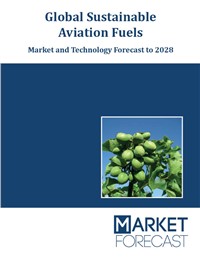The Global Sustainable Aviation Fuel (SAF) Market is expected to grow at a CAGR of around 24.33% during the forecast period, the market is expected to grow from USD 8.24 Billion in 2020 to around USD 48 Billion in 2028. The cumulative market is expected to reach USD 234 Billion.
The Global SAF market is expected to be dominated by two regions – North America and Europe. North America and Europe combined are expected to account for around four fifths of the market. Agricultural potential for feedstock, growth in support infrastructure, global push to reduce greenhouse gas emissions and oil price fluctuations are some of the factors which would drive the global SAF market. Fischer Tropsch and Hydro Treated Esters and Fatty Acids would be the key production technologies for SAF.
Lack of investment, high production cost, lack of standards, strict environmental hurdles for aviation biofuels and lack of certification are some of the challenges to the growth of the SAF market. Heavy investments from investors are required for the aviation sector to transition from a conventional fuel to an SAF market. The cost per barrel of sustainable aviation fuel is also significantly higher than traditional jet fuels due to the procurement and transportation of feedstock. The aviation industry would be apprehensive about large scale commercial utilization of SAF until costs remain high.
SAF can be produced through four certified technologies as of now. They are Fischer Tropsch, Hydro Treated Esters and Fatty Acids, Synthesized Iso Paraffins and Alcohol to Jet technologies. Fischer Tropsch is expected to be the fastest growing technology and SAF produced through the Fischer Tropsch technology is expected to account for around USD 20 billion in 2028. The aviation fuel obtained from Fischer Tropsch are in many ways superior to its petroleum derived counterparts. However, Hydro Treated Esters and Fatty acids is the fastest growing SAF production technology during the forecast period.
HEFA would grow at a CAGR of 33.91% during the forecast period. HEFA is a superior technology when compared to the other Sustainable Aviation Fuel production technologies in terms of maturity and cost-efficiency. HEFA also has the lowest production complexity when compared to the other SAF technologies and is therefore it is most likely to be used as an initial technology for production. Halophytes is expected to be the fastest growing feedstock out of these segments and would grow at a CAGR of 52.03% during the forecast period. The availability of feedstock is one of the key factors for the growth of SAF.
Scope
The study period of the report titled “Global Sustainable Aviation Fuel Market and Technology Forecast to 2028” is 2018-2028 and the forecast period is 2020 - 2028. The fuel production technologies covered in this report are Fischer Tropsch, Hydro Treated Esters and Fatty Acids, Synthesized Iso Paraffins and Alcohol to Jet.
Segmentation covered in this report
The report titled “Global Sustainable Aviation Fuel Market and Technology Forecast to 2028” is segmented based
By Regions
- North America
- Europe
- APAC
- Middle East
- Rest of the World
- Municipal solid wastes
- Cellulosic waste
- Used cooking oil
- Camelina
- Jatropha
- Halophytes
- Algae
- Non-biological feedstock and others
- Fischer Tropsch
- Hydro Treated Esters and Fatty Acids
- Synthesized Iso Paraffins
- Alcohol to Jet technologies
Reasons to Buy
- The report will help investment bankers and the financial institutions to understand
- the overall market trend and the key dynamics that govern this market.
- The report will help manufacturers to understand the key opportunity market and
- focus their efforts in those specific regions.
- The report will help the top management team to take strategic decisions on
- opportunity analysis or market entry strategies.
- The infrastructure and feedstock suppliers in the SAF market are expected to benefit from this report, the market forecast section would help them understand the market
- potential at the component level. The key companies from the top ten countries have been discussed in detail in the Country Analysis section.
- The key industries which would be impacted by SAF have been discussed in detail, this is one of the most comprehensive reports which discusses SAF industries.




